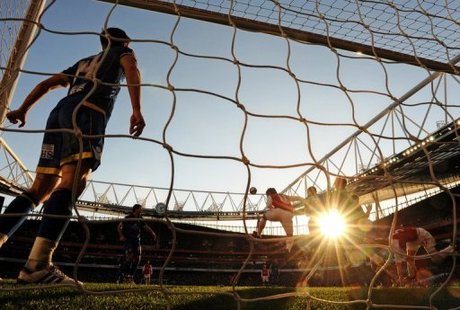Brazil Using Football to Tackle Youth Unemployment

In the Rio de Janeiro suburb of Curicica, teenagers hold hands in pairs during a kickabout. But rather than scoring goals, team-work is the name of the game in this football match -- and finding jobs.
"It's not a football academy," said Heloisa Andrade, director of the "Partners of the Americas" institute, a Washington-based non-governmental organization founded in 1964, initially as part of the U.S. government.
"The goal is to help them have a better future," she added.
Since 2005, the "Partners" have introduced football as an extra dimension to the high school syllabus to Curicica and other programs in Latin America to develop skills.
But no-one here talks about football ability, despite the focus on the game and its status as the national sport in Brazil, which hosts next year's Confederations Cup and the 2014 World Cup.
The small educational and sports center is located in a run-down area among shabby houses and a spaghetti tangle of overhead electricity wires, 30 kilometers (18.5 miles) west of the center of Rio.
Like many countries around the world, Brazil has been affected by the economic downturn. In 2010, the South American giant's economy grew at a rate of 7.5 percent but last year expanded only 2.7 percent.
Forecasts are for 1.2 percent growth in 2012 -- the worst rate for any of the emerging BRICS countries of Brazil, Russia, India, China and South Africa.
Unemployment stood at a record low of 5.3 percent in October, according to official figures, but among the country's 18- to 24-year-olds, that figure rises nearly three-fold to 14.6 percent.
In the metropolitan region of Rio, including the lower-class and lower middle-class neighborhood of Curicica, 12.2 percent of young people were out of work.
Unemployment -- plus persistent social inequalities and poverty, particularly among the black Brazilian community, and women -- make schemes such as those run by the "Partners" much in demand.
Some 2,500 girls and boys have been through programs with names such as "Vencer" (Triumph) or "Ganar" (Win).
"Two-thirds of them have found a job afterwards," Federico Addiechi, who is in charge of social projects at football's world governing body FIFA and which is backing the scheme, told AFP.
"We give money but also materials and then we help them to raise funds, improve their management and communication so our contribution is more sustainable."
On a basketball court surrounded by loose netting, about a dozen boys and girls in yellow bibs and sports kit play football in the stifling early December heat, holding hands but trying not to put the ball in the back of the net.
"This exercise is about solidarity -- holding hands even if you don't have the ball -- but also about respect and sexual equality," said Addiechi, who also heads the FIFA's "Football for Hope" scheme promoting the game as a development tool.
Andrade, whose project is part of "Football for Hope", agrees, seeing "the beautiful game" was a way to learn vital skills for the world of work.
"Football as a conduit of shared values, discipline, working towards a goal, team-work... these are the things that you find in the jobs market," she said.
Off the pitch, students at the center, who either come through word of mouth or via canvassing in schools, learn everything from English to how to write a covering letter for a job application.
Wallace Nascimento, 16, is one of them.
"I've learnt a lot here in terms of communication. Once, I gave a presentation on a technical project, which I'd never done before," he said.
With his shaven head, Flamengo supporter Wallace bears a passing resemblance to Brazil international midfielder Lucas Moura, who will soon be leaving Sao Paolo for French giants Paris Saint-Germain.
But the teenager doesn't see himself as a future football star, despite the major football tournaments coming to the country and the hysteria surrounding them.
He wants to be an aviation mechanic.



